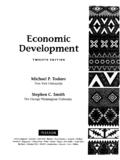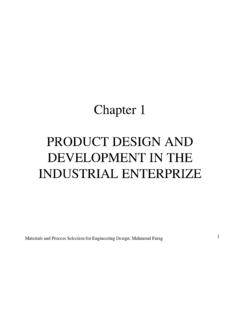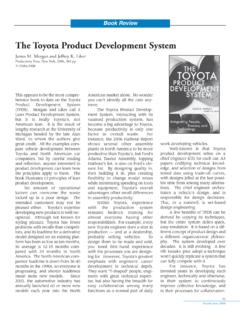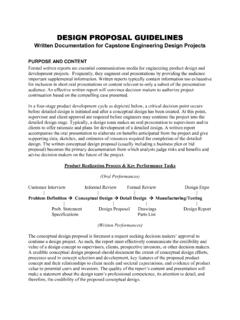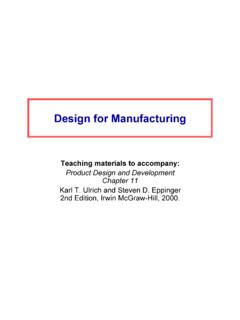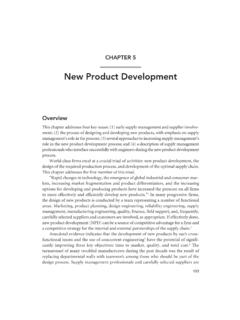Transcription of Product Design and Development - GBV
1 Product Designand DevelopmentFifth EditionKarl T. UlrichUniversity of PennsylvaniaSteven D. EppingerMassachusetts Institute of TechnologyI McGraw-HillI IrwinContentsAbout the Authors ivPreface vAcknowledgments viiChapter 1 Introduction 1 Characteristics of Successful ProductDevelopment 2 Who Designs and Develops Products? 3 Duration and Cost of Product Development 5 The Challenges of Product Development 6 Approach of This Book 6 Structured Methods 7 Industrial Examples 7 Organizational Realities 7 Roadmap of the Book 8 References and Bibliography 10 Exercises 10 Thought Question 10 Chapter 2 Development Processesand Organizations 11 The Product Development Process 12 Concept Development : The Front-EndProcess 16 Adapting the Generic Product DevelopmentProcess 18 Technology-Push Products 18 Platform Products 20 Process-Intensive Products 20 Customized Products 20 High-Risk Products 21 Quick-Build Products 21 Complex Systems 21 Product Development Process Flows 22 The Tyco Product Development Process 23 Product Development Organizations 25 Organizations Are Formed by Establishing Linksamong Individuals 25 Organizational Links May Be Aligned with Functions,Projects, or Both 25 Choosing an Organizational Structure 28 Distributed Product Development Teams 28 The Tyco Product Development Organization 30 Summary 30 References and Bibliography 31 Exercises 32 Thought Questions 32 Chapter 3 Opportunity Identification 33 What Is an Opportunity?
2 34 Types of Opportunities 34 Tournament Structure of OpportunityIdentification 36 Effective Opportunity Tournaments 37 Opportunity Identification Process 39 Step 1: Establish a Charter 39 Step 2: Generate and Sense ManyOpportunities 40 Techniques for Generating Opportunities 40 Step 3: Screen Opportunities 46 Step 4: Develop Promising Opportunities 47 Step 5: Select Exceptional Opportunities 47 Step 6: Reflect on the Results and the Process 49 Summary 50 References and Bibliography 50 Exercises 51 Thought Questions 51 Chapter 4 Product Planning 53 The Product Planning Process 54 Four Types of Product Development ProjectsThe Process 5655 Contents xiStep 1: Identify Opportunities 57 Step 2: Evaluate and Prioritize Projects 57 Competitive Strategy 58 Market Segmentation 58 Technological Trajectories 59 Product Platform Planning 60 Evaluating Fundamentally New ProductOpportunities 61 Balancing the Portfolio 63 Step 3: Allocate Resources and Plan Timing 64 Resource Allocation 64 Project Timing 66 The Product Plan 66 Step 4: Complete Pre-Project Planning 66 Mission Statements 67 Assumptions and Constraints 68 Staffing and Other Pre-Project PlanningActivities 69 Step 5: Reflect on the Results and the Process 69 Summary 70 References and Bibliography 70 Exercises 72 Thought Questions 72 Chapter 5 Identifying Customer Needs73 Step 1: Gather Raw Data from Customers 76 Choosing Customers 78 The Art of Eliciting Customer Needs Data 79 Documenting Interactions with Customers 80 Step 2.
3 Interpret Raw Data in Terms of CustomerNeeds 81 Step 3: Organize the Needs into a Hierarchy 83 Step 4: Establish the Relative Importanceof the Needs 86 Step 5: Reflect on the Results and the Process 87 Summary 88 References and Bibliography 88 Exercises 89 Thought Questions 90 Chapter 6 Product Specifications 91 What Are Specifications? 92 When Are Specifications Established? 93 Establishing Target Specifications 94 Step 1: Prepare the List of Metrics 95 Step 2: Collect Competitive BenchmarkingInformation 99 Step 3: Set Ideal and Marginally Acceptable TargetValues 99 Step 4: Reflect on the Resultsand the Process 103 Setting the Final Specifications 103 Step I: Develop Technical Modelsof the Product 105 Step 2: Develop a Cost Model of the Product 106 Step 3: Refine the Specifications, Making Trade-OffsWhere Necessary 108 Step 4: Flow Down the Specifications asAppropriate 109 Step 5: Reflect on the Resultsand the Process 111 Summary 111 References and Bibliography 112 Exercises 113 Thought Questions 113 AppendixTarget Costing 114 Chapter 7 Concept Generation117 The Activity of Concept Generation 118 Structured Approaches Reduce the Likelihoodof Costly Problems 119A Five-Step Method 119 Step 1.
4 Clarify the Problem 120 Decompose a Complex Problem into SimplerSubproblems 121 Focus Initial Efforts on the CriticalSubproblems 123 Step 2: Search Externally 124 Interview Lead Users 124 Consult Experts 125 Search Patents 125 Search Published Literature 126 Benchmark Related Products 127 Step 3: Search Internally 127 Both Individual and Group Sessions CanBe Useful 128 Hints for Generating Solution Concepts 129xii ContentsStep 4: Explore Systematically 130 Concept Classification Tree 132 Concept Combination Table 134 Managing the Exploration Process 137 Step 5: Reflect on the Solutions and the Process 139 Summary 140 References and Bibliography 141 Exercises 142 Thought Questions 142 Chapter 8 Concept Selection143 Concept Selection Is an Integral Partof the Product Development Process 144 All Teams Use Some Method for Choosing aConcept 145A Structured Method OffersSeveral Benefits 148 Overview of Methodology 149 Concept Screening 150 Step 1: Prepare the Selection Matrix 150 Step 2: Rate the Concepts 151 Step 3: Rank the Concepts 152 Step 4: Combine and Improve the Concepts 152 Step 5: Select One or More Concepts 152 Step 6: Reflect on the Resultsand the Process 153 Concept Scoring 154 ,'Step 1: Prepare the Selection Matrix 154 Step 2: Rate the Concepts 155 Step 3: Rank the Concepts 156 Step 4: Combine and Improve the Concepts 156 Step 5.
5 Select One or More Concepts 156 Step 6: Reflect on the Resultsand the Process 157 Caveats 157 Summary 159 References and Bibliography 159 Exercises 160 Thought Questions 16iAppendix AConcept-Screening Matrix Example 162 Appendix BConcept-Scoring Matrix Example 163 Chapter 9 Concept Testing 165 Step 1: Define the Purpose of the Concept Test 167 Step 2: Choose a Survey Population 167 Step 3: Choose a Survey Format 168 Step 4: Communicate the Concept 169 Matching the Survey Format with the Means ofCommunicating the Concept 173 Issues in Communicating the Concept 173 Step 5: Measure Customer Response 175 Step 6: Interpret the Results 175 Step 7: Reflect on the Resultsand the Process 178 Summary 179 References and Bibliography 179 Exercises 180 Thought Questions 180 AppendixEstimating Market Sizes 181 Chapter 10 Product Architecture183 What Is Product Architecture?
6 184 Types of Modularity 186 When Is the Product Architecture Defined? 187 Implications of the Architecture 187 Product Change 187 Product Variety 188 Component Standardization 189 Product Performance 189 Manufacturability 190 Product Development Management 191 Establishing the Architecture 191 Step 1: Create a Schematic of the Product 192 Step 2: Cluster the Elements of the Schematic 193 Step 3: Create a Rough Geometric Layout 195 Step 4: Identify the Fundamental and IncidentalInteractions 196 Delayed Differentiation 197 Platform Planning 200 Differentiation Plan 200 Commonality Plan 201 Managing the Trade-Off between Differentiationand Commonality 202 Contents xiiiRelated System-Level Design Issues 202 Defining Secondary Systems 203 Establishing the Architecture of the Chunks 203 Creating Detached Interface Specifications 204 Summary 204 References and Bibliography 205 Exercises 206 Thought Questions 206 Chapter 12 Design for Environment229 Chapter 11 Industrial Design207 What Is Industrial Design ?
7 209 Assessing the Need for Industrial Design 211 Expenditures for Industrial Design 211 How Important Is Industrial Design to a Product ? 211 Ergonomic Needs 212 Aesthetic Needs 213 The Impact of Industrial Design 213Is Industrial Design Worth the Investment? 213 How Does Industrial Design Establish a CorporateIdentity? 216 The Industrial Design Process 2171. Investigation of Customer Needs 2172. Conceptualization 2173. Preliminary Refinement 2184. Further Refinement and Final ConceptSelection 2185. Control Drawings or Models 220 /6. Coordination with Engineering, Manufacturing,and External Vendors 220 The Impact of Computer-Based Tools on the IDProcess 220 Management of the Industrial Design Process 221 Timing of Industrial Design Involvement 222 Assessing the Quality of Industrial Design 2241. Quality of the User Interface 2242. Emotional Appeal 2243.
8 Ability to Maintain and Repair the Product 2244. Appropriate Use of Resources 2265. Product Differentiation 226 Summary 226 References and Bibliography 227 Exercises 228 Thought Questions 228 What Is Design for Environment? 231 Two Life Cycles 232 Environmental Impacts 233 History of Design for Environment 234 Herman Miller's Journey toward Design forEnvironment 234 The Design for Environment Process 235 Step 1: Set the DFE Agenda: Drivers, Goals,and Team 236 Identify the Internal and External Drivers of DFE 236 Set the DFE Goals 237 Set Up the DFE Team 23 7 Step 2: Identify Potential EnvironmentalImpacts 239 Step 3: Select DFE Guidelines 240 Step 4: Apply the DFE Guidelines to the InitialProduct Design 242 Step 5: Assess the Environmental Impacts 243 Compare the Environmental Impacts to DFE Goals 244 Step 6: Refine the Product Design to Reduce orEliminate the Environmental Impacts 244 Step 7.
9 Reflect on the DFE Process andResults 245 Summary 247 References and Bibliography 247 Exercises Questions 249 AppendixDesign for Environment Guidelines 250 Chapter 13 Design for Manufacturing253 Design for Manufacturing Defined 255 DFM Requires a Cross-Functional Team 255 DFMIs Performed throughout the DevelopmentProcess 255 Overview of the DFM Process 256 Step 1: Estimate the Manufacturing Costs 256 Transportation Costs 259 Fixed Costs versus Variable Costs 259 The Bill of Materials 260 Estimating the Costs of Standard Components 261xiv ContentsEstimating the Costs of Custom Components 261 Estimating the Cost of Assembly 262 Estimating the Overhead Costs 263 Step 2: Reduce the Costs of Components 264 Understand the Process Constraints and CostDrivers 264 Redesign Components to Eliminate ProcessingSteps 265 Choose the Appropriate Economic Scale for the PartProcess 265 Standardize Components and Processes 266 Adhere to "Black Box " Component Procurement 267 Step 3: Reduce the Costs of Assembly 268 Keeping Score 268 Integrate Parts 268 Maximize Ease of Assembly 269 Consider Customer Assembly 270 Step 4: Reduce the Costs of SupportingProduction 270 Minimize Systemic Complexity 271 Error Proofing 2 71 Step 5.
10 Consider the Impact of DFM Decisions onOther Factors 272 The Impact of DFM on Development Time 2 72 The Impact of DFM on Development Cost 272 The Impact of DFM on Product Quality 273 The Impact of DFM on External Factors 273 Results 273 Summary 275 References and Bibliography 276 Exercises 277 Thought Questions 278 Appendix AMaterials Costs 279 Appendix BComponent Manufacturing Costs 280 Appendix CAssembly Costs 286 Appendix D 'Cost Structures 287 Chapter 14 Prototyping289291 Understanding PrototypesTypes of Prototypes 291 What Are Prototypes Used For?Principles of Prototyping 297 Analytical Prototypes Are Generally More FlexibleThan Physical Prototypes 297 Physical Prototypes Are Required to DetectUnanticipated Phenomena 297A Prototype May Reduce the Risk of CostlyIterations 298A Prototype May Expedite Other DevelopmentSteps 300A Prototype May Restructure TaskDependencies 301 Prototyping Technologies 3013D CAD Modeling and Analysis 301 Free-Form Fabrication 302 Planning for Prototypes 303 Step 1: Define the Purpose of the Prototype 303 Step 2: Establish the Level of Approximationof the Prototype 304 Step 3: Outline an Experimental Plan 304 Step 4: Create a Schedule for Procurement,Construction, and Testing 304 Planning Milestone Prototypes 305 Summary 306 References and Bibliography 307 Exercises 308 Thought Questions 308 Chapter 15 Robust Design311294 What Is Robust Design ?
